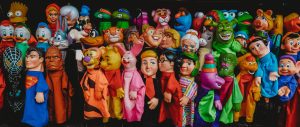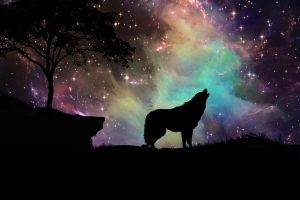Photo by Yannick Pulver on Unsplash
The great appeal to playing a tabletop RPG is that it allows you to be anyone and anything. Aside from the game system’s rules and your Storyteller’s restrictions, your imagination is the limit.
But, as with any other time where you have an abundance of options, this often leads to a sort of paralysis. An endless tableau of characters stretches before you, just waiting for the earliest stages of creation in your mind. Where do you begin?
That’s what I’m planning to help you with in this guide to Werewolf: the Apocalypse character concepts. I’ll explain to you what character concepts are, how to develop them on your own, and then provide you a few character concepts of my own as examples.
What is a Character Concept?

I always like to start from the beginning when I write a more guide-oriented post like this one. That means the first question I want to answer is, “what is a character concept?” Of course, this applies to tabletop RPGs in general – it isn’t strictly limited to Werewolf: the Apocalypse, but I guess that’s the game I’m writing it for.
I define a character concept as the “shell” of a character. It’s the basic idea of one, the prologue to character creation. It’s when you think to yourself, “You know what would be funny? A character that does *insert random career/action/idea*.”
As an example, I’ve been playing Call of Cthulhu again lately. Call of Cthulhu, as a game about Lovecraftian, eldritch horrors, often punishes characters for being intelligent enough to comprehend the terrors they experience. It’s not a combat-heavy game like Werewolf: the Apocalypse can be, but sometimes, combat still happens…which begs the question, how do you fight something that drives you insane when you so much as look at it?
This gave me an idea. If it takes intelligence to comprehend that a creature you’re looking at isn’t natural, then why not make someone so unintelligent, they can simply never comprehend what’s going on while still being functional? Thus, the concept for country bumpkin was born: a charismatic, brawny farmhand who can handle themselves in a fight, but has a low intelligence. To them, every unearthly creature is just “some kinda weird dog or something” because they’re simply not very bright.
Country Bumpkin hasn’t been given stats or written down onto a character sheet. They’re just an idea for a character to be created in the future. This is a character concept.
How To Develop a Character Concept in Werewolf: the Apocalypse
Before I share some of my character concept ideas with you, I want to help you determine the best strategy for coming up with your own. You know the saying: give a man a fish and he’ll eat for a day but teach him to fish and he’ll eat for the rest of his life.
I know how confusing it can be to create a new character. Creativity isn’t something that can be formulated, and making a character is an act of creativity.
But trust me when I say that, in many ways, the character concept is the hardest step. Once you can reliably make your own character concepts, most the other pieces, such as stats and abilities, fall into place. Your character concept is like a frame.
So, let’s look at some strategies you can use to begin developing your own character concept…
Think about how you want to play.
Remember, playing a tabletop RPG like Werewolf: the Apocalypse should be fun. It’s something you should look forward to, not dread.
A logical starting point, then, is thinking about how you want to play the game. Ask yourself what types of characters you have the most fun playing. Do you like combat? Do you want a character with a stronger spiritual side? Would you prefer to play someone with refined social skills that persuades and negotiates?
Maybe you even like some combination of the above-mentioned things. Aside from restrictions of the system and your Storyteller, your character can be virtually whatever you want them to be. This is where I recommend starting if you have some experience with tabletop RPGs and kind of know what your playstyle is like already.
List some characters you like most and what you like about them.

If you don’t have any experience playing tabletop RPGs, don’t fret. There are other approaches you can take to developing a character concept.
One approach I recommend for people in your shoes is to try emulating other fictional characters. Take inspiration from your favorite characters in any type of show, book, or movie.
You can make a list of a few. There doesn’t need to be an exact number here or anything. Once you have a list, think about what you specifically like about each character.
You may even start to notice a trend. For instance, maybe you discover that you like powerful, decisive characters who aren’t afraid to charge into battle. On the other hand, maybe you like sneaky, deceptive characters who are good at formulating complex lies on the spot.
When you play a tabletop RPG, you’re in a unique position to make a new potential favorite character, tailored just to your preferences and interests. It’s not a bad idea to let your pre-existing favorite characters give you some pointers.
Contemplate themes that are important to you.
Another angle to approach it from is to think of themes that interest you. This may be something you even notice while you’re listing off characters that you enjoy. If not, though, there’s no reason why you can’t do this part separately.
When I say themes, I mean basically single words that represent important concepts. For example, religion could be a theme you’re interested in. You could create a werewolf struggling to reconcile their condition with a particular religion. Maybe their new way of life is their religion – many Garou (werewolves) treat their existence as an extremely spiritual one.
Communicate with other players to determine if a vital role is missing.
Although it’s not impossible to be the only person playing the game with a Storyteller, it’s unlikely. Odds are, you’re playing with a group, and that’s why teamwork is often vital to tabletop RPGs.
So, if you find yourself totally unable to develop a character concept, start by looking at what everyone else in your group is doing. I promise it’s not like cheating and looking at someone else’s test. By communicating with other players, you may discover that there’s a role missing.
As an illustration, say that everyone in your group made very aggressive, combat-focused characters. This leaves an obvious gap: who’s going to be the face – the person who does all the smooth talking for the group? Who’s going to be the intellectual or the leader who calms others down?
In each of those questions, the answer could be you.
Consider the World of Darkness overall and its flavor.
Finally, let’s not forget one of the most important aspects of the game: the very world in which it takes place, the World of Darkness. The World of Darkness is essentially just the modern world, but with an (arguably) seedier underbelly in addition to a hidden population of supernatural creatures.
You would do well to read the core rulebook for Werewolf: the Apocalypse to build your understanding of the setting. My personal favorite is the 20th anniversary edition, because it is frankly the only copy I currently own and I feel like it’s a shockingly fun read.
You’ll get to see samples of different types of characters you could make. You may find that this gives you some much-needed inspiration when it comes to designing your own characters.
Even if you’re not getting a more specific character concept as you read, you’ll at least learn which types of roles fit best into the universe.
Sample Character Concepts
Before I show you some character concepts I came up with, let me give you a couple disclaimers…
First: these concepts are all specifically for werewolves. They are not for other changing breeds, because creating concepts for all the changing breeds would be kind of exhausting.
If you really want me to talk about the Fera, I would be happy to make character concepts for each kind in their own individual posts. Let me know if you’d be interested in something like that by leaving a comment below.
Second: These are basic shells and ideas. I’m not going to go into detail creating stats or recommending gifts for you to choose.
That being said, I think I’ll recommend potential tribes for you to consider, as well as maybe discuss whether the character in question would be more or less difficult to roleplay.
1. Opposing forces.

I don’t know about you, but I’ve always been drawn to the idea of opposites. I like the concept of somehow forcing opposing forces to collide and coexist with each other.
In the World of Darkness, werewolves are naturally enemies of vampires. They see vampires as agents of the Wyrm, an ancient and corrupt deity-like being that represents decay. So, what if you could in some way force a werewolf and a vampire to coexist?
You can’t have a hybrid Garou/Kindred, but you could make a werewolf who knows a vampire. In this character concept, there are two siblings. Your character becomes a werewolf, but your sibling, in a sick twist of fate, is embraced by a vampire.
Would you spend the rest of your life trying to hunt down and “free” your sibling from the depraved life of a vampire? Would you simply pretend he or she no longer exists?
This is a more roleplay-heavy concept, and it doesn’t necessarily lead to a particular type of character, so you can technically tack it onto any type of build. As always, it depends on whether your Storyteller would allow this sort of background, as well.
Roleplay Difficulty: Hard
Suggested Tribe: Any
2. The melding of nature and technology.
This is in line with the previous idea of bringing together two opposites. In this case, though, I’m looking at two other traditionally opposing forces: technology and nature.
To some degree, this is already done with the Glasswalker tribe. Werewolves in general tend to shy away from technology-studded areas such as cities, perceiving that technology comes from the Weaver, an entity representing order.
Glasswalkers, however, embrace technology, often being as adept with computers as anyone else in the modern era. I suggest taking it a step further and designing a werewolf whose sole focus is technology, such as a coder/hacker type of character.
To up the ante, consider making a werewolf that was heavily scarred or wounded in battle. On the other hand, you may even choose to design a Metis, a werewolf produced by the union of two werewolf parents, leading to grotesque physical mutations. Technology may be what your character turns to as a way of hiding their injuries or deformities behind a virtual mask.
Roleplay Difficulty: Medium
Suggested Tribe: Glasswalker
3. Spokesperson for the dead.

Another concept I personally find interesting is the supernatural. Whichever side of the fence you sit on when it comes to all things spiritual and paranormal, you can fully immerse yourself in the supernatural in Werewolf: the Apocalypse.
In fact, there’s a whole spirit world called the Umbra that most werewolves can slip into effortlessly. There are also ghosts and spirits galore for you to interact with.
Enter the Silent Striders. This tribe of werewolves is well-known for their interactions with the dead. Ghosts are drawn to these Garou like beacons, leading Silent Striders to become a sort of emissary for the deceased.
Why not lean into it? Why not make a wizened wolf who builds relationships with ghosts? I think making an almost medium-like werewolf is a nifty idea and would be both mechanically and roleplay-wise interesting.
Roleplay Difficulty: Hard
Suggested Tribe: Silent Strider
4. Survivor of the Black Spiral.
Okay, so we’re going to have to dive a little deeper into the lore than I intended here in order to give you a better understanding of what this concept entails. I’ve touched on the existence of the Umbra briefly, but it’s important to explain that there are layers.
Think of the Umbra like the ocean. If you stay in the shallows, it’s much safer. But you can go deeper, swimming out into the Deep Umbra if you’re certain you know how to return. Within the Deep Umbra, there is something known as the Spiral Labyrinth.
Black Spiral Dancers, a corrupted tribe of werewolves, are wolves who were said to have been forced to walk the Spiral Labyrinth by servants of the Wyrm until they went insane. It’s uncommon for someone forced to walk the Spiral Labyrinth to emerge mentally intact to the point where they’re still playable, but there’s no reason why your Storyteller couldn’t allow this to be the case in your campaign.
Your character could potentially be a Black Spiral Dancer who, by the grace of Gaia, was somehow able to turn away from the corruption. Or perhaps your character was taken by servants of the Wyrm and forced to walk the Spiral Labyrinth, barely escaping.
Roleplay Difficulty: Hard
Suggested Tribe: Any, Black Spiral Dancer
5. The ultimate warrior.

Werewolves in general are good at smashing face, but if you’re really into combat, you might want a character that’s much better than average in this regard. This is where the ultimate warrior concept comes into play.
There are a couple things you’ll want to choose to ensure your character really is the bloodiest. Auspice will be vital here, and I suggest going with Ahroun. As for tribe, a Black Fury or Get of Fenris would do nicely.
Keep in mind your rage is going to be higher naturally, so be prepared to deal with the possibility of your character blowing up at the drop of a hat.
Roleplay Difficulty: Easy
Suggested Tribe: Black Furies, Get of Fenris
6. Leader of the pack.
Wolves are naturally social creatures. In the game, every single werewolf belongs to multiple groups, and arguably the most important is their pack. A pack is a close-knit grouping of werewolves that choose to work together. Packs do not need to come from the same tribe, and sometimes, packs can consist of multiple changing breeds.
One thing remains the same, however, regardless of the pack’s makeup: it needs a leader, a voice of reason. One character concept you can use, then, is the archetype of a leader.
Your werewolf doesn’t need to be beefy to build a leader. Like with making a warrior, though, your auspice will be important, and I recommend Philodox for this one. I also suggest putting some points in your Social attributes.
Roleplay Difficulty: Hard
Suggested Tribe: Shadow Lord or Silver Fang would be good, but you could feasibly do this with any tribe.
7. The wisdom of madness.
One thing I’ve always loved about White Wolf games is that they incorporate this sort of wise insanity trope. A character that seems insane on the surface is actually full of wisdom, and it is often said they see the true nature of things.
It’s easy to do this in Vampire: the Masquerade by simply building a Malkavian, but things get more interesting in Werewolf: the Apocalypse if you want to do something similar. Auspice will matter more than tribe here again, so go with Ragabash for your auspice.
Roleplay Difficulty: Hard
Suggested Tribe: Any
8. One who works with other changing breeds.
Werewolves are neat and all, but many players are more fascinated by the abundance of other shapeshifters in the World of Darkness. I, for example, have always wanted to play a wereraven, also known as a corax.
If you’re playing a werewolf and your friends want to play other creatures, things can get a little sticky. You see, werewolves are, well, racist against other changing breeds. And that’s putting it lightly – hundreds of years ago, werewolves destroyed entire species of shapeshifters in the War of Rage. Understandably, some changing breeds are still a wee bit uncomfortable around the Garou to this day.
But it’s not totally impossible to make a werewolf who’s willing to work with the Fera, and I’ve done it before. Stargazers, one werewolf tribe, are well-known for their ability to work with other shapeshifters, so I suggest you go with a Stargazer here.
Beyond that, you can do virtually anything you want. I might recommend looking for ways to reduce your Rage, though, so you’re less at risk of losing control and potentially massacring your companions.
Roleplay Difficulty: Medium
Suggested Tribe: Stargazer
9. Struggling with spirituality.

Werewolves are intensely spiritual creatures. Remember, they are well aware of the Umbra, a spiritual world that mirrors the physical one – and it is just as real as the world we live in. Some werewolves (Silent Striders, to be precise) even possess an awareness of and kinship with the Underworld.
The first werewolf transformation often occurs during puberty. This means there are several or more years of life in which a werewolf might not know they’re a werewolf.
What if your character already had a deep, sincerely held spiritual belief system prior to their transformation? How would their transformation affect their spiritual beliefs? Would they cling to their old religion, or force themselves to let go in the face of their new truths?
I think this would be an interesting character to roleplay. A devoutly Catholic, Muslim, or other type of Christian werewolf would be intriguing.
Roleplay Difficulty: Hard
Suggested Tribe: Any
10. A lupine bard.
In Dungeons and Dragons, the bard is a very traditional type of character. Bards represent the epic storytellers and singers throughout history who have managed to inspire legions of people.
If you’re drawn to a bardic concept, rest assured that it is a possibility in Werewolf: the Apocalypse. Wolves howl, after all, so it only makes sense that you can easily make a lupine bard.
Here’s how: choose Galliard for your auspice. This is literally the phase of the moon that represents storytellers and those who bestow courage on others. You can be a bit more flexible when it comes to tribe, but if you want to really hit the nail on the head, make a Fianna werewolf.
You’ll have essentially made a Celtic bard werewolf. If that isn’t kind of a fun idea, I don’t know what is.
Roleplay Difficulty: Easy
Suggested Tribe: Any, but Fianna is especially fitting.
Wrap Up
I know this article got a little long-winded, but I felt it was important to write. The concepts in it can be useful for pretty much all tabletop RPGs – not just Werewolf: the Apocalypse.
My intent was to help people who maybe aren’t as strong in writing to develop their own characters going forward. With any luck, you find this process a little less intimidating in the future.

